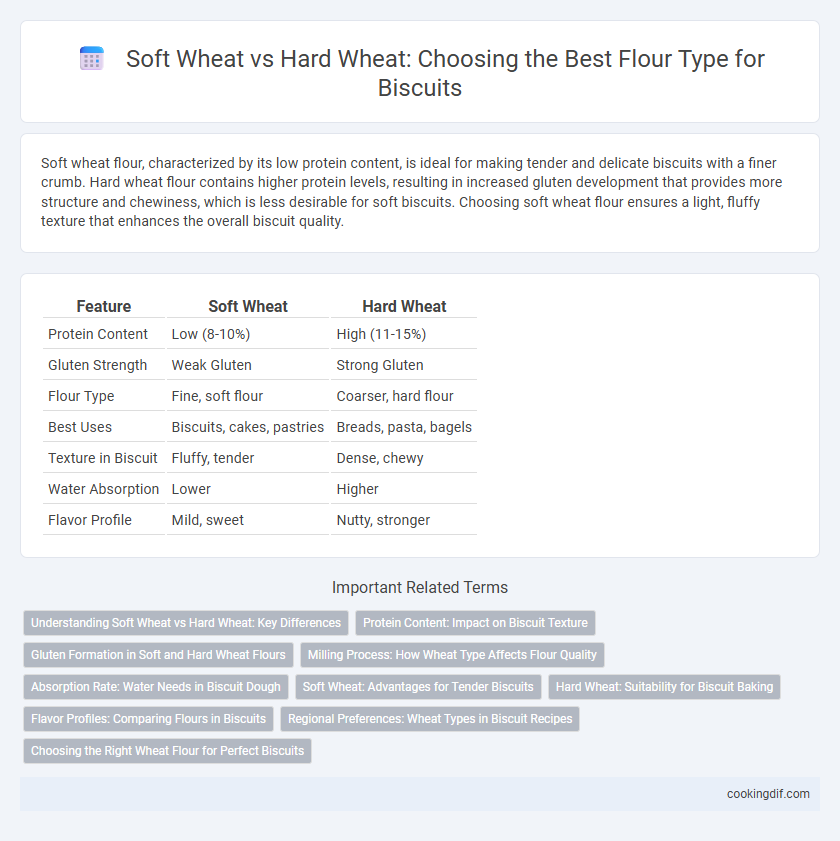Soft wheat flour, characterized by its low protein content, is ideal for making tender and delicate biscuits with a finer crumb. Hard wheat flour contains higher protein levels, resulting in increased gluten development that provides more structure and chewiness, which is less desirable for soft biscuits. Choosing soft wheat flour ensures a light, fluffy texture that enhances the overall biscuit quality.
Table of Comparison
| Feature | Soft Wheat | Hard Wheat |
|---|---|---|
| Protein Content | Low (8-10%) | High (11-15%) |
| Gluten Strength | Weak Gluten | Strong Gluten |
| Flour Type | Fine, soft flour | Coarser, hard flour |
| Best Uses | Biscuits, cakes, pastries | Breads, pasta, bagels |
| Texture in Biscuit | Fluffy, tender | Dense, chewy |
| Water Absorption | Lower | Higher |
| Flavor Profile | Mild, sweet | Nutty, stronger |
Understanding Soft Wheat vs Hard Wheat: Key Differences
Soft wheat flour contains lower protein content, typically around 8-11%, making it ideal for tender baked goods like biscuits due to its fine texture and light crumb. Hard wheat flour, with higher protein levels ranging from 12-14%, develops more gluten, resulting in denser, chewier products unsuitable for delicate biscuits. Choosing soft wheat flour ensures optimal softness and flakiness in biscuit recipes by providing the right balance of structure and tenderness.
Protein Content: Impact on Biscuit Texture
Soft wheat flour, characterized by a lower protein content of around 8-10%, produces tender and crumbly biscuits ideal for delicate textures. Hard wheat flour contains higher protein levels, typically 12-14%, resulting in stronger gluten development that can make biscuits denser and chewier. Choosing soft wheat flour enhances biscuit softness and flakiness by minimizing gluten formation during baking.
Gluten Formation in Soft and Hard Wheat Flours
Soft wheat flour contains lower gluten-forming proteins, resulting in weaker gluten development ideal for tender biscuits with a delicate crumb. Hard wheat flour has higher gluten content, creating stronger gluten networks that can make biscuits denser and chewier. Choosing soft wheat flour ensures optimal gluten formation for soft, flaky biscuit texture.
Milling Process: How Wheat Type Affects Flour Quality
Soft wheat's lower protein and gluten content result in finer, lighter flour ideal for tender biscuits, while hard wheat produces higher-protein flour suited for bread but less desirable for delicate crumb textures. Milling soft wheat involves gentler grinding to preserve starch integrity and produce a finer, more consistent flour particle size, enhancing biscuit flakiness. Hard wheat requires more intensive milling to break down the tougher kernel, often resulting in coarser flour that affects biscuit softness and rise.
Absorption Rate: Water Needs in Biscuit Dough
Soft wheat flour typically has a lower protein content, resulting in a reduced absorption rate of water compared to hard wheat flour. Hard wheat flour demands more water during biscuit dough preparation, enhancing gluten development and dough strength. Optimizing water absorption is crucial for achieving the ideal biscuit texture and consistency.
Soft Wheat: Advantages for Tender Biscuits
Soft wheat flour, characterized by its lower protein content (typically 8-10%) compared to hard wheat, is ideal for producing tender biscuits due to reduced gluten development. The fine texture and low gluten strength in soft wheat flour ensure a delicate crumb and melt-in-the-mouth softness, essential qualities for high-quality biscuits. Bakers favor soft wheat flour to achieve consistent tenderness and optimal rise, enhancing the biscuit's overall palatability and customer appeal.
Hard Wheat: Suitability for Biscuit Baking
Hard wheat flour, characterized by its high protein content and strong gluten network, provides the necessary structure and elasticity for biscuit dough, resulting in a tender yet sturdy texture. Unlike soft wheat flour, which yields a finer crumb and more delicate biscuits, hard wheat enhances dough machinability and increases moisture retention during baking. Bakers prefer hard wheat flour for biscuits needing durability and uniform rise, crucial in commercial biscuit production.
Flavor Profiles: Comparing Flours in Biscuits
Soft wheat flour, with its lower protein content, creates biscuits that are tender and crumbly, enhancing delicate buttery flavors. Hard wheat flour, higher in gluten, produces denser biscuits with a chewier texture and a robust, slightly nutty taste. Choosing soft wheat flour emphasizes lightness and subtle sweetness, while hard wheat imparts a heartier, more pronounced flavor in biscuit recipes.
Regional Preferences: Wheat Types in Biscuit Recipes
Soft wheat flour, with its lower protein content and finer texture, is preferred in biscuit recipes across regions like the United States and the United Kingdom for producing tender, crumbly biscuits. Hard wheat flour, higher in gluten, is favored in areas such as Canada and parts of Europe where denser, chewier biscuit textures are traditional. Regional preferences for wheat types directly influence biscuit texture and rise, making soft wheat the ideal choice for achieving light, flaky results.
Choosing the Right Wheat Flour for Perfect Biscuits
Soft wheat flour, characterized by its lower protein content (typically 7-9%), produces tender, flaky biscuits ideal for delicate textures. Hard wheat flour, with higher protein levels (11-14%), creates stronger gluten networks resulting in denser, chewier biscuits. Choosing soft wheat flour ensures light, airy biscuits with optimal crumb structure for classic Southern-style baking.
Soft wheat vs hard wheat for flour type Infographic

 cookingdif.com
cookingdif.com